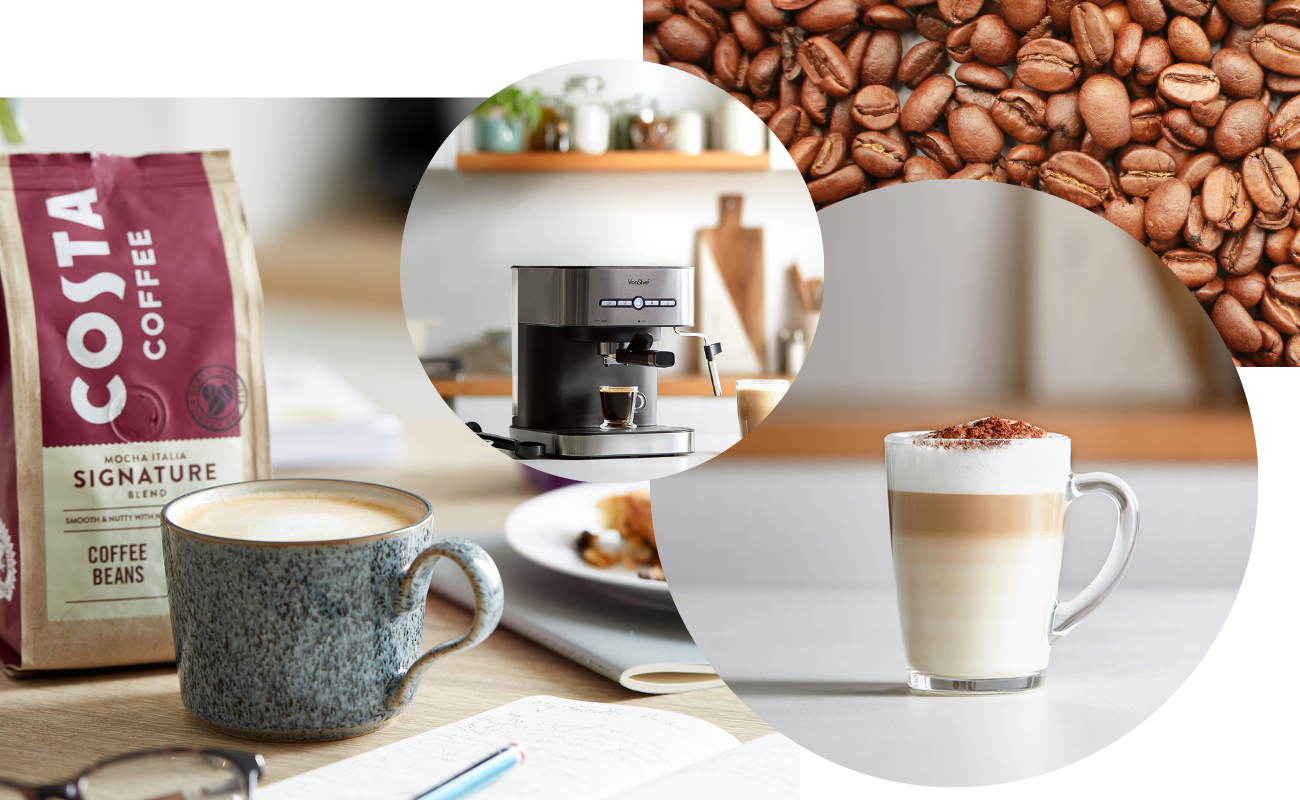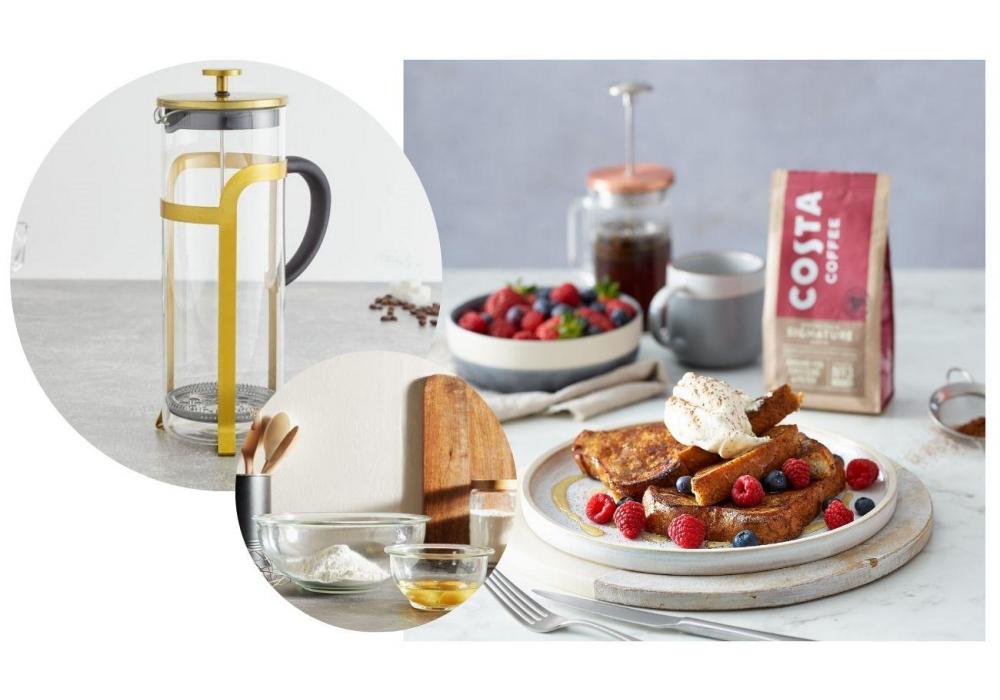The beginner’s guide to choosing great coffee
Coffee is a staple across the UK, and indeed the world. But did you know how easy it is to improve your brew by simply picking the right beans, milk, and coffee maker?
In this article, we’ve outlined how to choose between types of coffee, the differences between espresso and filter machines, the dairy-free milk varieties that’ll elevate even the best tasting black coffee, and healthy alternatives to your morning brew.


What to consider when picking coffee beans
Each bean has its own flavours and unique place on the coffee tasting wheel. To help you choose the best beans to brew, we’ve outlined the differences in tasting notes between roasts, processing methods, and picking locations.
Type of roast
There are three kinds of ways to roast coffee beans, with each giving a different flavour profile
Light roast: The longer beans are roasted, the more mass they lose. As a result, light roast beans keep much of their original flavour, which makes for a unique coffee tasting experience. Typically, light roasted beans are brewed as a filter coffee, to extract every ounce of rich flavour.
Medium roast: Medium roast beans are slightly less acidic and full-bodied than light roast, offering a more rounded flavour profile. This kind of coffee maintains many of the origin flavours, while also picking up some of the richness from the roast. Placed between light and dark, medium roast beans can be brewed as a filter or espresso coffee.
Dark roast: Dark roast coffee tasting notes are typically rich, bold, and chocolatey. The deep flavour is often formed almost entirely in the roast with few origin characteristics remaining, as opposed to light roast beans which rely on the natural coffee qualities. Dark roast coffee beans should usually be brewed as an espresso.
Processing method
When coffee beans are picked, they come with a thick casing, skin, and sugary mucilage that needs removing before brewing. There are three different ways to do this, with each outlined below.
Washed: Washed processing involves removing the coffee bean’s inedible layers before they’re allowed to dry out. This means the rich coffee flavour you’re getting reflects the true and authentic flavour of the beans, with no influence from the sweet mucilage. It gives a clean and crisp coffee profile.
Natural: Rather than removing the inedible layers straight away, as is the case with washing coffee, natural processing involves letting the bean dry out entirely before removing the casing and mucilage. This allows the beans to absorb the sweet fruitiness from the mucilage, and gives you a heavy-bodied coffee.
Pulped: Pulped processing (also referred to as honey processed because of how sticky the beans get) combines elements of washed and natural processing. The beans are de-pulped to remove the very outer layers, but the mucilage is left intact for drying. This gives the coffee a sweetness without being too heavy-bodied.
Origin of bean
Where beans are grown can have a huge impact on your coffee tasting experience, depending on conditions such as temperature, rainfall, soil quality, and sunlight.
Typically, the best coffee is grown in Central/South America, Africa, and South Asia. Each of these three regions sit between the tropics of Cancer and Capricorn, which is commonly referred to as the coffee belt. Examples of popular coffee regions include:
Brazil: Brazilian blends are typically rich with hints of chocolate and spice, as well as offering a sweet nutty aroma. Beans from Brazil are also often heavy-bodied, which makes them well-suited to espresso coffee.
Colombia: Colombian beans are generally quite mellow, which makes for a gentle coffee tasting experience. Also expect sweet and caramelly undertones, with a hint of chocolate.
Ethiopia: The origin of arabica, considered around the world to be the premium bean, Ethiopian coffee tasting notes are complex and aromatic. Ethiopian beans are also likely to offer a sweet and syrupy flavour profile.
India: Heavy-bodied, earthy, and tropically spiced, Indian coffee beans are herbal and savoury, with hints of syrupy sweetness. These characteristics are also reminiscent of Indonesian beans.
Choosing a coffee machine
Whether you’re looking for the best tasting black coffee or a complex brew topped off with a little milk, you’ll likely be picking between an espresso and filter coffee machine. We’ve outlined the two and what you can expect from each.
Espresso
Italian for ‘expressed’, espresso machine coffee is exactly that: quick and easy. It’s made by forcing hot water through finely ground and compacted beans, which results in a thick and concentrated shot, typically served in a little cup.
This emulsification that results from the process means the taste is strong and rich. But espresso doesn’t just mean a shot of strong coffee; you can use it as a base for other variations, such as a cappuccino, latte, or macchiato.
Filter
The difference between filter coffee and espresso is that filter machines don’t force hot water through ground coffee beans. Instead, the water will naturally make its way through the beans at its own pace, allowing it to absorb more of the coffee fragrances. This slower process gives you a milder taste, but one that’s more intricate and complex.
What is the best milk alternative for coffee?
Whole milk is the most widely regarded among baristas for flavour and richness, but it’s not for everyone. Whether you’re lactose-intolerant or looking for something with a lower fat content, we’ve outlined the best alternatives for an equally delicious coffee tasting experience.
Oat milk
Oat milk is a staple and perhaps the best milk alternative for coffee, because it maintains a lot of the smooth and rich creaminess you get with full-fat dairy. It’s also high in fibre, which makes it a great choice for the digestive health.
Coconut milk
Thick, creamy, and high in fat content, coconut milk is the ideal addition to your cup of coffee if you want something that replicates the texture of traditional cow milk. But be aware that tinned milk is often a lot more coconutty than cartons!
Rice milk
An increasingly popular pick, rice milk is one of the best alternatives to cow milk if you’re sensitive to dairy and soy. It’s not overpowering in the slightest and allows your rich coffee tasting notes to really come through. However, it’s quite a thin milk, which means you lose out on a lot of creaminess.
Are there any healthy alternatives to coffee?
We’ve gone through the ways you can maximise your coffee tasting experience, but we also appreciate that you might want to mix things up a little for a healthier lifestyle. Discover our top three healthy alternatives to coffee.
Chicory coffee
Chicory is one of the best healthy alternatives to coffee, because it has much less caffeine than the real thing while mirroring many of the same flavours. Instead of using coffee beans, though, this drink is made by roasting chicory root.
Matcha tea
Matcha is a powdered version of green tea, which allows you to absorb the nutritional value directly. While matcha doesn’t have the same flavour as coffee, it does have similar caffeine levels to your morning brew. However, matcha’s makeup means your body absorbs the caffeine more gradually, which makes you less likely to suffer a mid-morning crash.
Chai tea
Chai tea is a version of black tea that combines various herbs and spices – the main flavour is generally cinnamon, though, which gives it a sweet fragrance. If you’re trying to cut down on your caffeine, chai contains considerably less than coffee beans.
A great cup of coffee is an important part of countless people’s mornings and days, so it’s important to understand how to get the best out of your beans! Discover even more kitchen essentials, including our range of cafetieres, or check out our blog for more inspiration and expert advice.





 Need help?
Need help?

